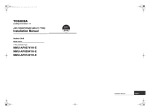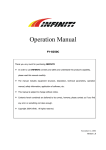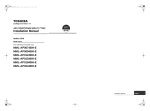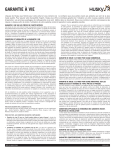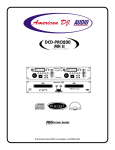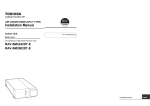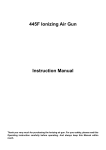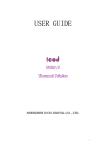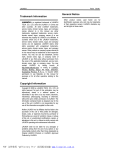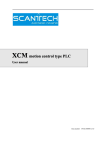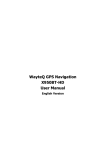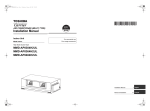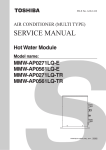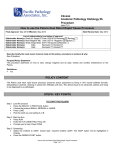Download User manual
Transcript
Histo-Pro200 Vacuum Tissue Processor Operation Manual Read carefully before working the instrument. 1. Important notes 1.1 Qualification of personnel 1) The HISTO-PRO200 may be operated only by trained laboratory personnel. 2) All laboratory personnel designed to operate the HISTO-PRO200 must read this instruction manual carefully and must familiar with all technical features of the instrument. 1.2 Designed use summarize The HISTO-PRO200 Vacuum Tissue Processor is the necessary equipment for pathology processing specimens. It is a modular automated tissue processor designed for the laboratory applications as fixation, dehydration, paraffin wax infiltration of histological tissue specimens. The instrument may be operated only according to the instructions contained in this manual. 2. Safety warning 2.1 Site requirements 1) The instrument must be set up in a clear space of about 650 x 700 mm 2) Room temperature constantly between +10 °C and +35 °C. 3) Relative humidity maximum 80%, non-condensing. 4) Avoid vibrations, direct sunlight and heavy variation in temperature. 2.2 Safety matters ● Use proper nominal supply voltage. ● The input power supply must have a good ground. ● Install away from flammable and explosive objects ● Never open instrument without authorization to prevent high voltage shock ● Service should be done only by authorized personnel. ● Check regularly the parameters showed during operation ● Disconnect instrument from power supply after use ● Use proper fuses ● Use only proper power cord ● Install the instrument away from any interference source ● Equipment which needs heating must not be heated without liquid 2.3 Warnings-Operating the instrument ● The instrument may only be operated by trained laboratory personnel, according to its designed use and per the present instruction manual. ● Do not move the wax drain hose until the fill or drain has be completed, as pressurized air is used to clear the hose after each fill/drain. ● After refilling/replacing the reagent bottles ensure that the lids are tighten. ● The bottles must be properly pushed home into the bottle suitable position. ● Fixatives containing mercuric salts, acetic or picric acid will corrode metallic components in the instrument. ● After each step paraffin step a retort clean cycle must be run. 2.4 Warnings-Handling reagent ● Be careful when handling solvents. ● Always wear rubber gloves and safety goggles when handling the chemicals used in this instrument. ● Reagent used for tissue infiltration can be both toxic or flammable. ● Use caution when handling paraffin wax or removing baskets-molten paraffin is hot and may cause burns. ● Avoid personal contact with paraffin stations and retort walls-they can be very hot as well. ● Do not clean reagent bottles in an automatic dishwasher. 2.5 Warning-Cleaning and maintenance ● Prior to each maintenance and/or cleaning, switch the instrument off and disconnect mains power. ● Do not clean the instrument with solvents containing acetone or xylene. No liquid may be spilled into the internal components of the instrument-neither during operation nor during cleaning. ● The condensate bottle should be inspected at least one week and, if necessary, emptied. 3. Instrument features and specifications 3.1 Overview-------instrument Front View 1. Control Panel: LCD displays all the operation information. 2. Paraffin wax baths 3. Gas System 4. Retort 5. Reagent distribute system 6. Reagent bottles The processor module contains three paraffin wax baths, a processing retort, and also LCD display as well as the electronic components. The cassettes are held in three baskets, each of which has a capacity of up to 100 cassettes. All processing occurs in the stainless steel retort under the pressure, vacuum and temperature conditions selected. Rear Panel 1. Power Switch 2. AC220V Power Socket 3. Power fuse: 10A 4. Fan: AC220V / 50HZ 18W 3.2 Technical Data Nominal voltage: AC220V Nominal frequency: 60HZ Main fuses: 10A Nominal power: 1000 VA Dry weight, unpacked: approx. 100 kg Weight, packed: 120 kg Operating temperature range: 15 °C to 35 °C Relative humidity: 10 % to 80 %, non-condensing Paraffin wax baths Number of baths: 3 Volume (liters): 4.0 l per bath Melt time: approx. 3 hrs Temperature: 65 ℃ Temperature accuracy: + 1 ℃ Retort Capacity: approx. 200 cassettes Reagent volume (in liters): 5.3 Temperature (paraffin): 65 °C Temperature (processing reagents): ambient or 35°C Temperature (cleaning reagents): 65 °C Temperature accuracy: + 1 °C Filling time: 5 min Drain time: 5 min Impregnation vacuum: -70 kPa (g) Impregnation pressure: 35 kPa (g) Fill vacuum: -70 kPa (g) Drain pressure: 35 kPa (g) General Reagent bottles: 9 Cleaning solution bottles: 3 Maximum bottle volume: 4.0 l Recirculation (pump in/out): ON/OFF Time between cycles: 15 min Hardware and Software: • Large color Liquid Crystal Display (LCD) • User-friendly, intelligent software. • Alarm system to reminder wrong operation and trouble • Multiple specimen protection system. Capacities: • 15 programs that consist of up to 9 reagent and 3 paraffin wax steps. • Time per program step: 0 to 99 hours, 59 minutes. • Up to 200 cassettes can be processed simultaneously. • Wax clean program. • 9 reagent bottles. • 3 wax baths. • 3 cleaning solution bottles. • 2 condensate bottle. 4. Installation 4.1 Installation site requirement 1) No other instruments nearby which might cause vibrations. 2) Stable tabletop, enough space far from wall to ensure Histo-Pro200 normal working. 3) Room temperature about between +15℃- 40℃. 4) Relative humidity maximum 80%, non-condensing. 5) Avoid vibrations, direct sunshine and heavy variation in temperature. Note: The chemical to be used in the Histo-Pro200 are both flammable and noxious. The Pro200 must be set up in a well ventilated area free from any ignition sources. Do not operate instrument in rooms with explosion hazard. 4.2 Connect 4.2.1 Connect Power Connect the Power cord to the Mains power inlet socket. If applicable, then turn on the power switch at the rear panel. The Electronic Touch Screen will be displayed. Note: ● The instrument must be connected to an earthed mains power outlet socket only. ● It is recommended that the Histo-Pro200 be plugged into a wall socket that has Ground Fault Circuit Interruption protection-as an additional electrical safeguard. ● Make sure to use the appropriate mains cable for the local voltage supply(wall outlet). 4.2.2 Connect fill/drain hose Connect the supplied fill/drain hose to the drain connection on the front of instrument as following. Note: Make sure the hose be locked well and ensure a clear passage for fluid flow. 5. Operation 5.1 Display Panel ● Function of indicator lamp Paraffin: When this lamp lights, it means the paraffin tank is in heating state. Work: When this lamp lights, it means the retort is in heating state. Tank Station: When this lamp lights, it means the system works in the bottle. ● Function of key Press this key to make the system enter the automatic operation state. Press this key to set the parameter for each reagent bottle. Press this key to set the previous step parameter. Press this key to set the next step parameter. Press this key to add the unit's digit number while in setting parameter state. Press this key to add the tens digit number while in setting parameter state. Press this key to decrease the unit's digit number while in setting parameter state. Press this key to decrease the tens digit number while in setting parameter state. Press this key to confirm the setting parameters. Press this key to exit the current running. Press this key to stop the current running, press again to go on running. 5.2 Principle of Vacuum Tissue Processor work According to the Tissue processing requirements, choose the suitable reagents. From the No. 1 to No. 9 bottles are used for store common dehydration reagents. No. 10 to No. 12 tanks are used for store paraffin, while processing heating to the set temperature. No. 13 to No. 15 bottles are used for store clean reagents. During running automatically, the system will run according to the set program. Put the tissue samples into the retort, system will fill the each bottle reagent to the retort step by step. While processing, each ten minutes will agitate the reagent in retort, to make the tissue speeding dehydration. While the current step running time reach to the set time, the retort reagent will drain back to the former bottle. The system will fill the next bottle reagent to the retort according to the set program. Processing the same steps, till the program will be run finished. In retort, for the No. 1 to No. 9 bottles common dehydration reagents, the temperature set about 30℃. For the No. 10 to No. 12 tanks paraffin, the temperature set about 65℃. For the No. 13 to No. 15 bottles clean reagent, the temperature set about 30℃. 5.3 Operation of Vacuum Tissue Processor 5.3.1 Turn on Vacuum Tissue processor Switch on the power switch, a short beeper sound. The system enters the Standby mode. The screen displays as following. Now a new program can be set, or operate in manual mode. If the program has been set ready and be choose, press the AUTO key to run automatically. 5.3.2 Setting up the instrument parameter From the Histo-Pro200 keyboard, press the “SET” key go to the “Set Program” screen. The screen displays as following. On the screen contents, the red words are the changeable parameters. The user can according to requirements to set each parameter. ● Set wax temperature in the paraffin wax bath. According to user requirement, set the working wax temperature from 60-70℃. The default temperature is 68℃. ● Set program working time. 1) Choose a required program to set. It can store eight programs in memory totally. 2) Set the each step time for the program. It has twelve steps totally. Press “Up” “Down” and “1st+” “1st-” “2nd+” “2nd-” to set each step time number. ● Set local time. Set the local time for Histo-Pro200. The all parameters set range: 1) Paraffin tank temperature: 60℃ to 70℃. 2) Each step work time: 0 to 99 H 59 M. 3) Year: 2000 to 2099 4) Month: Jan. to Dec. 5) Day: 1 to 31 6) Hour: 0 to 23 H 7) Minute: 0 to 59 M 8) Program No.: 1 to 8 After set finish the page parameters, press “Confirm” key to store them. If want cancel the parameters, press “Stop” key to give up store. The system will enter to the next set page, the screen display as following. ● Set the retort temperature. 1) According to user requirement, if in retort is reagent, press the “Up” “Down” and “1st+” “1st-” “2nd+” “2nd-” set the suitable temperature. The default temperature is 30℃. 2) If in retort is paraffin, set the suitable temperature for paraffin. The default temperature is 65℃. ● Set the three pipes temperature. Set the Pipe A, Pipe B, Pipe C temperature respectively. The default temperature is 65℃. ● Set the Liquid level alarm function is ON or OFF. According to user requirement, Press the “DOWN” key to choose the liquid level alarm function is on or off. If the alarm is on, so if the any bottle reagent is low (not enough for deal), it will has an alarm to remind user to add reagent to the bottle. Now the LCD display Status: “The bottle reagent is not enough! Please add liquid.” ● Set vacuum condition According to user requirement, Press the “DOWN” key to choose the Histo-Pro200 is working under vacuum condition or not. If working under vacuum condition, while working the retort will stay in vacuum condition, the retort cover will can’t be opened while working. The parameters default number is: 1) Paraffin in retort temperature: 65℃ 2) Reagent in retort temperature: 30℃ 3) Three pipes temperature: 65℃ 4) Liquid level alarm: OFF After set finish the page parameters, press “Confirm” key to store them. If want cancel the parameters, press “Stop” key to give up store. 5.3.3 Running a program automatically For running a program automatically, press the “AUTO” key on the keyboard. The screen displays as follows. 1) Automatic running steps: The System enters the Automatic Run interface, it will display the Running Program No., now select a program using the “Up” and “Down” keys to run. After selected, it will display this program total running time. The user can according to the total running time to decide the a suitable start time for the program. Now on the LCD display “Status” shows that: “Press Confirm to start automatic run….”After make sure to run the program, press the “CONFIRM” Key to start run the program automatically. The system will run according to the set program. Put the tissue samples into the retort, system will fill the each bottle reagent to the retort step by step. While processing, each ten minutes will agitate the reagent in retort, to make the tissue speeding dehydration. While the current step running time reach to the set time, the retort reagent will drain back to the former bottle. The system will fill the next bottle reagent to the retort according to the set program. Processing the same steps, till the program will be run finished. Now the system reminds message “Work finished, press Stop to drain the liquid”. After drain finished the paraffin, system reminds message “Close the retort cover, then press Confirm to clean the retort.” Note: After take away the tissue samples, should clean the residual paraffin by manual. Press “Confirm” key to clean the retort automatically. Five minutes filling clean liquid, three steps for washing tanks, and five minutes draining liquid. After three clean step finished, the system will enter the standby mode. During processing, if the supply power will be cut off, the system protects automatically and stores the run parameters. Details consult the Power supply failure protection chapter (5.3.6). Note: While in Automatic running state, the program can’t be modified. 2) During automatic running, the status news: During automatic running, the LCD will display the each step running information, as following. ● System is filling reagent to retort. ● System is changing reagent. ● Fill liquid finished, system is running, please wait… ● System is draining liquid from retort, please wait… ● Work finished, Press stop to drain the liquid. ● Close the retort cover, then press confirm to clean the retort. After the automatic run finished, and take away the tissue sample. Now the retort should be cleaned. Close the retort cover, and press Confirm key to start clean. ● The bottle reagent is not enough! Please add liquid. If the liquid sensor alarm function is ON, now has a long alarm accompanying. After the reagent add enough, the instrument will know automatic and go on running automatically. ● System is decreasing pressure. Please keep the retort cover in seal. During running, if the instrument is not be set in vacuum condition, now the retort cover be opened. So during the system is decreasing pressure, should let the retort cover in seal. ● System is heating…please wait. 5.3.4 Manual Running The manual mode can be used for few tissue sample test, and instrument maintenance. Press “Manual” key to enter the manual running operation. The LCD displays as follows. While in Manual mode: 1) System reminds message “Set the reagent number to run. Press Confirm to start running.” First input fill liquid bottle number, then press “Confirm” key to find this bottle automatically, and begin to filling reagent. The news “System is filling reagent to retort”. 2) After filling finished, system reminds message “Fill liquid finished. Press Stop to drain the liquid.” As the message operation. 3) While drain liquid, system reminds message “System is draining liquid from retort. Please wait…” 4) After draining finished, if no any more other operation. Press “Exit” to enter the standby mode. Note: The Manual Running operation can’t fill the paraffin (No. 10, No. 11 and No. 12 bottle). Because in this state, it can’t be heated. 5.3.5 Turn off Vacuum Tissue Processor Switch off the supply power switch, so the vacuum Tissue Processor is turn off. But because the some special points should be take care while turn off the instrument, the user should know some knowledge, to avoid any trouble. 1) System is in standby mode, now can turn off the instrument safely. 2) System is in manual mode, if the liquid has be filled to retort, should press “Stop” key to finish the manual work. System will drain the liquid automatically. After drain finished the liquid, press “Exit” key to back the standby mode. Now it can turn off the instrument safely. 3) System is in automatic run mode, now if it must turn off the instrument, so should press “Exit” key to force drain the liquid from retort. After drain finished the liquid, it will back to the standby mode, now it can turn off the instrument safely. 5.3.6 Power Supply failure protection 1) System is in standby mode, if power supply failure, the instruments cut off. While supply power recovers, system will still enter the standby mode. 2) System is in set up instrument parameters mode, if power supply failure, system will not store the set parameters. While supply power recovers, system will still enter the standby mode. 3) System is in manual mode, if power supply failure: A. If retort hasn’t be filled liquid, now the instruments cut off. While supply power recovers, system will still enter the standby mode. B. If retort has filled liquid inside, now the instruments cut off. While supply power recovers, first will drain back the reagent to the bottle, then enters to the standby mode. 4) System is in automatic run mode, if power supply failure, system will remember the current run time and other parameters. After the supply power recovers, system will remind message “System is heating…Please wait.” Now it will heating automatically till the set temperature, then system will go on running as the memory record. 5.3.7 Suddenness protection For the Vacuum Tissue Processor, the most suddenness is overheating problem, also the aftermath will be very bad. So the instrument has two protection way. One is the program temperature control, if the system test the temperature is overheating, will switch off the heating immediately. Second is temperature sensor install attached the retort. If the temperature over 90 degree, the sensor will switch off. If any suddenness is happen, should turn off the instrument immediately. After check the troubleshooting, then turn on the instrument. (About turn off instrument, refer to the 5.3.5 Turn off Vacuum Tissue Processor). 6. Cleaning and maintenance 6.1 Paraffin wax baths 1) Wipe the wax baths and lids clean The lid can be removed for cleaning purposes. 2) If they are dirty, remove the wax strainers from the wax baths. Clean, dry and reinsert them. 3) Ensure that the air vent hole at the top rear right hand corner is unobstructed. Warning: Be careful as the walls of the wax baths are very hot and may cause burns. 6.2 Instrument exterior Clean the instrument exterior as necessary. Wipe with a damp cloth moistened with mild detergent and dry. Note: Do not use solvents on painted surface and the LCD screen. 6.3 Draining the condensate bottle Remove and empty the condensate bottle and reinsert. Note: Dispose of waste solvents with care according to local regulations and the waste management policy of the company or institution. 6.4 Clean the retort lid 1) Remove the wax from the inside from of the retort lid and from around the retort lid seal with the plastic scraper provided. Thoroughly remove all wax deposits from the around the lid seal. 2) For convenience, the lid may be removed during cleaning. Lift the lid to a vertical position, release the hinge lock and pull the lid toward you. Note: Only use the plastic scraper provided when cleaning the retort lid and seal to avoid damage to the retort lid seal and to the PTFE coating on the retort lid. Do no damage the edges of the seal with the scraper. 6.5 Clean the retort The retort may be wiped clean using a cloth moistened with solvent (Xylene or alcohol) or mild detergent. Ensure that the air holes at the top front of retort are open. 6.6 Clean the retort strainer Use alcohol or Xylene to clean the strainer located at the bottom of the retort. For convenience, the strainer can be taken out to remove all solid dirt. 6.7 Clean the processor module top surface To ensure proper sealing of the lids at all times, it’s important that you: 1) Remove both lids for cleaning. 2) First scrape the stainless steel surface with the plastic scraper and then wipe down to remove all solid matter around the retort and paraffin wax stations. 6.7 Clean the reagent bottles 1) Empty and clean the reagent bottles using a bottle brush and a laboratory detergent in warm water. Note: Never clean reagent bottles in an automatic dishwasher. The reagent bottles are not dishwasher-proof. 2) Refill and reconnect the bottles once cleaned. Make sure the bottle lids are tight and the bottles are properly seated in their home position at the rear of reagent cabinet. Note: The reagent bottles must be properly engaged in the home position in the connection manifolds at the rear inner wall of the reagent module. Failure to correctly plug reagent bottles into the manifold will cause an interruption to the processing run and may result in spilling of reagents. 3) While the reagent bottles are outside of the reagent cabinet, wipe the stainless steel inner wall of the reagent cabinet with a damp cloth moistened with a mild detergent. 6.8 Checking the retort lid seal Regularly check the retort lid seal for damage. If the seal is damaged, it must replaced without delay. 7. Troubleshooting Trouble Reason & Solve The air cushion of the retort pump is indurate. The retort can’t fill reagent The vibrating velum of the retort pump is broken. The valves of retort are not opened. If the inside fan The fuse is broken. doesn’t work No any display on The switch power supply is damaged. LCD while switch If the inside fan LCD display is broken. on the instrument works The LCD display connection wire is damaged. The liquid level sensor is damaged. The check liquid level is abnormal The Control board is broken. The The distributing The distributing valve light on the Control valve isn’t running board isn’t on, the PCB is broken. distributing The distributing valve motor is broken. valve works The abnormal distributing The photoelectricity sensor is broken. valve is running all The Control board is broken. the time. If the LCD display 99℃, so the temp. The heating parts are abnormal. sensor is broken. The Control board is broken. While press the keyboard key, no any The connection wire between the control response. board and LCD is damaged. The Control board is broken.
























